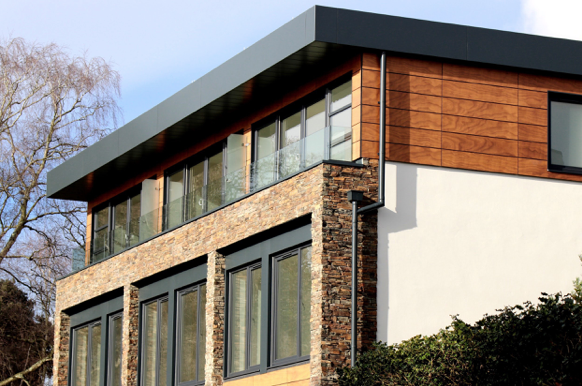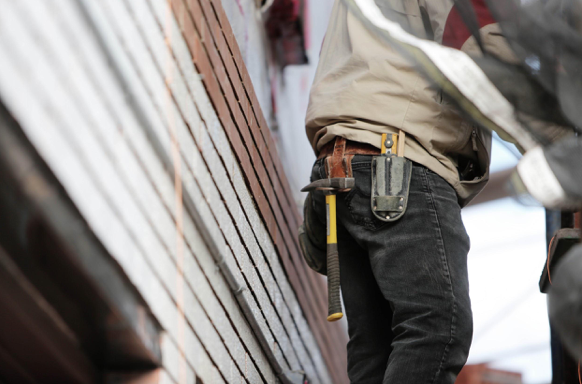
How construction can mirror sustainability in interior design
The principles of sustainability are hot on the lips of every environmentalist, employer and politician in recent years, with the concept trickling down into every industry and corner of modern society. Sustainability in design is not a recent phenomenon but, with the built environment accounting for 45% of total UK carbon emissions, sustainable design is more important than ever as we look to reduce our impact on the planet.
Interior design and construction go hand-in-hand, and both industries can learn a lot from each other’s sustainable policies and processes – so, in today’s article, we’ll be exploring ways construction can mirror sustainability in interior design.
Materials matter
Although materials differ between the two industries, the rawest way to action sustainability in any construction or interior design project is by sourcing sustainable materials to use throughout. With IKEA & Form Us With Love designing a kitchen unit made from exactly 25 recycled plastic bottles, it’s clear that the opportunity to creatively utilise environmentally-friendly materials is endless. As Form Us With Love CEO, Jonas Pettersson, puts it: “A plastic bottle is not waste; it is a resource” – highlighting a forward-thinking attitude that all construction and design companies can aspire to.
Of course, we’re not talking solely about recycled materials here – nobody expects a skyscraper to be built from plastic bottles. But, when you narrow down materials into their core groups: woods, plastics/polymers, metals, textiles etc. it becomes clearer and easier to look for sustainable solutions in each category. From sustainable solid woods such as cork, timber and bamboo used in interior design, through to geo-textiles and even sustainable concrete, the materials you use should stay sensitive to the environment and minimise impact – for the short-term and long-term benefit of our planet.
Forward-thinking
To make sustainability an innate part of the construction process, project managers should look to create and implement an environmental policy, either as part of the overall construction plan or as a stand-alone document. Interior designers, as with most designers, have increasingly used planning to highlight the environmental factors they have considered in their project.
Having a referenceable piece of documentation at later stages in construction can prove invaluable when examining the bigger picture, and shows compliance of the increasingly tighter regulations imposed on the construction industry. Plus, homes that meet a certain level of sustainability can qualify for certifications like BREEAM and Passivhaus, which benefit both the builder and the end-user with higher energy efficiency and a ‘green’ accreditation.
You should set clear, achievable targets that cover the key elements of the build: procurement, tender, transport, disposal and design are all relevant areas where improvements to green standards can be made and policies can be put in place. Having a concrete plan in place will help you implement green practices at every level of the workforce, putting sustainability at the core of the project and ensuring standards are met and objectives are in place.
Once standards and policies come into practice, construction companies could look to get accreditation through schemes like Green Mark or ISO 14001 – proving their dedication to environmentally-aware practices.
Every little helps
Although there are many things that we’d all like to do to be a bit greener, sometimes it’s not feasible to achieve everything with the resources at hand. While we’d all love to design oxygen-rich tree-draped skyscrapers or roofs that harvest rainwater, working within our means often means taking a smaller approach to sustainability.
Small adaptations in construction planning and design have the potential to make a meaningful impact in the move towards sustainability, and this sentiment is shared by those in the interior design community too – where the rising prevalence of LED lighting, indoor composters and energy-efficient windows highlights the steady-steps sentiment.
Innovations like solar roofs give the construction industry the chance to ‘go green’ at every level of the build. Smaller changes can be introduced; such as; to make a positive impact on your construction sustainability. To make a positive impact on your construction sustainability, smaller changes can be introduced – like effective rainwater recycling systems and adequate insulation to reduce the need for heating.
Doing things differently has become increasingly important in a continuously competitive landscape, across both interior design and construction. With the two intrinsically matched, it’s easy to envision how they can work together in the future to make entirely sustainable living a reality in new builds.
With every build, construction companies are offered the chance to reduce their impact on the planet, and to join our generation in defining sustainability for the future – and with our guidance, you can be one step closer to reducing your footprint in 2017.
Latest news

19th April 2024
ASSA ABLOY: Access solutions can impact sustainability performance across the full life-cycle of a building
Embedding sustainability within any organisation requires a broad, strategic perspective. Scrutiny should include the physical infrastructure itself: According to the IEA, buildings consume around 30% of global energy*. ASSA ABLOY has more…
Posted in Access Control & Door Entry Systems, Architectural Ironmongery, Articles, Building Industry News, Building Products & Structures, Building Regulations & Accreditations, Building Services, Case Studies, Doors, Facility Management & Building Services, Information Technology, Research & Materials Testing, Retrofit & Renovation, Security and Fire Protection, Sustainability & Energy Efficiency, Video of the Week
19th April 2024
British weather doesn't dampen spirit for new HMG Garden Paint
Despite one of the wettest starts to the year on record, customers are starting to plan for brighter days with HydroPro Garden Paint from HMG Paints.
Posted in Articles, Building Industry News, Building Products & Structures, Garden, Innovations & New Products, Paints, Paints, Coatings & Finishes, Restoration & Refurbishment, Retrofit & Renovation, Site Preparation, Sustainability & Energy Efficiency, Waste Management & Recycling
18th April 2024
Abloy UK showcases new digital portfolio at The Security Event 2024
Abloy UK is set to unveil its latest line-up of access control systems at The Security Event 2024, welcoming guests to explore its cutting-edge electromechanical and digital solutions on stand 5/F50.
Posted in Access Control & Door Entry Systems, Architectural Ironmongery, Articles, Building Industry Events, Building Industry News, Building Products & Structures, Building Services, Doors, Exhibitions and Conferences, Facility Management & Building Services, Health & Safety, Information Technology, Retrofit & Renovation, Security and Fire Protection
18th April 2024
Strand is a Failsafe Choice for Emergency Exit and Panic Hardware
In times of emergency, you’re in safe hands with Strand Hardware. Although there are many considerations for building specification, few decisions can be as critical as selecting the right emergency exit/panic hardware.
Posted in Access Control & Door Entry Systems, Architectural Ironmongery, Articles, Building Industry News, Building Products & Structures, Building Services, Doors, Facility Management & Building Services, Health & Safety, Restoration & Refurbishment, Retrofit & Renovation, Security and Fire Protection
 Sign up:
Sign up: 
